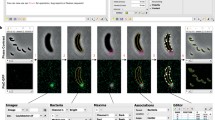Abstract
Microscopy is an essential tool for studying bacteria, but is today mostly used in a qualitative or possibly semi-quantitative manner often involving time-consuming manual analysis. It also makes it difficult to assess the importance of individual bacterial phenotypes, especially when there are only subtle differences in features such as shape, size, or signal intensity, which is typically very difficult for the human eye to discern. With computer vision-based image analysis — where computer algorithms interpret image data — it is possible to achieve an objective and reproducible quantification of images in an automated fashion. Besides being a much more efficient and consistent way to analyze images, this can also reveal important information that was previously hard to extract with traditional methods. Here, we present basic concepts of automated image processing, segmentation and analysis that can be relatively easy implemented for use with bacterial research.
Access this chapter
Tax calculation will be finalised at checkout
Purchases are for personal use only
Similar content being viewed by others
References
Danuser G (2011) Computer vision in cell biology. Cell 147(5):973–978. doi:10.1016/j.cell.2011.11.001
Sinha P, Balas B, Otrovsky Y, Russel R (2006) Face recognition by humans: nineteen results all computer vision researchers should know about. Proc IEEE 94(11):1948–1962. doi:10.1109/JPROC.2006.884093
Smith R (2009) Hybrid page layout analysis via tab-stop detection. Paper presented at the Proceedings of the 10th international conference on document analysis and recognition, Barcelona
Computer Vision in Medical Imaging (2014), vol 2. Computer Vision
Lojk J, Sajn L, Cibej U, Pavlin M (2014) Automatic cell counter for cell viability estimation. Paper presented at the 37th International Convention on Information and Communication Technology, Electronics and Microelectronics (MIPRO), Opatija
Farnoush A (1977) The application of an image analyzing computer (Quantimet 720) for quantitation of biological structures—the automatic counting of mast cells. Microsc Acta 80(1):43–47
Selinummi J, Seppälä J, Yli-Harja O, Puhakka JA (2005) Software for quantification of labeled bacteria from digital microscope images by automated image analysis. BioTechniques 39(6):859–863. doi:10.2144/000112018
Forero MG, Crisóbal G, Sroubek F (2004) Identification of tuberculosis bacteria based on shape and color. Real-Time Imaging 10(4):251–262. doi:10.1016/j.rti.2004.05.007
Forero MG, Crisóbal G, Alvarez-Borrego J (2006) Automatic identification of Mycobacterium tuberculosis by Gaussian mixture models. J Microsc 223(2):120–132. doi:10.1111/j.1365-2818.2006.01610.x
Vallotton P, Sun C, Wang D, Turnbull L, Ranganathan P (2009) Segmentation and tracking individual Pseudomonas aeruginosa bacteria in dense populations of motile cells. Paper presented at the Image and vision computing New Zealand, 24th International Conference, Wellington
Jung CR, Scharcanski J (2005) Robust watershed segmentation using wavelets. Image Vis Comput 23(7):661–669. doi:10.1016/j.imavis.2005.03.001
Mahmoudi L, El Zaart A (2012) A survey of entropy image thresholding techniques. Paper presented at the 2012 2nd International conference on advances in computational tools for engineering applications (ACTEA), Beirut
Canny J (1986) A computational approach to edge detection. IEEE Trans Pattern Anal Mach Intell 8(6):679–698. doi:10.1109/TPAMI.1986.4767851
Lindeberg T (1998) Edge detection and ridge detection with automatic scale selection. Int J Comput Vis 30(1):117–154. doi:10.1023/A:1008097225773
Kass M, Witkin A, Tersopoulos D (1988) Snakes: active contour models. Int J Comput Vis 1(4):321–331. doi:10.1007/BF00133570
Meyer F (1994) Topographic distance and watershed lines. Signal Process 38(1):113–125. doi:10.1016/0165-1684(94)90060-4
Otsu N (1979) A threshold selection method from gray-level histograms. IEEE Trans Syst Man Cybern 9(1):62–66. doi:10.1109/TSMC.1979.4310076
Ping-Sung L, Tse-Sheng C, Pau-Choo C (2001) A fast algorithm for multilevel thresholding. J Inf Sci Eng 17:713–727
Zhang Y, Wu L (2011) Optimal multi-level thresholding based on maximum Tsallis entropy via an artificial bee colony approach. Entropy 13(4):841–859. doi:10.3390/e13040841
Fang M, Yue G, QingCang Y The study on an application of Otsu method in Canny operator. In: Proceedings of the 2009 International Symposium on Information Processing, Huangshan, P. R. China, 21–23 August 2009. p 109–112
Zahara E, Fan S-KS, Tsai D-M (2005) Optimal multi-thresholding using a hybrid optimization approach. Pattern Recognit Lett 26:1082–1095. doi:10.1016/j.patrec.2004.10.003
Huang D-Y, Wang C-H (2009) Optimal multi-level thresholding using a two-stage Otsu optimization approach. Pattern Recognit Lett 30:275–284. doi:10.1016/j.patrec.2008.10.003
Acknowledgments
This work was supported by the Crafoord Foundation, the Swedish Research Council, the Swedish Society of Medicine, and the O.E. and Edla Johansson Foundation.
Author information
Authors and Affiliations
Corresponding author
Editor information
Editors and Affiliations
Rights and permissions
Copyright information
© 2017 Springer Science+Business Media New York
About this protocol
Cite this protocol
Danielsen, J., Nordenfelt, P. (2017). Computer Vision-Based Image Analysis of Bacteria. In: Nordenfelt, P., Collin, M. (eds) Bacterial Pathogenesis. Methods in Molecular Biology, vol 1535. Humana Press, New York, NY. https://doi.org/10.1007/978-1-4939-6673-8_10
Download citation
DOI: https://doi.org/10.1007/978-1-4939-6673-8_10
Published:
Publisher Name: Humana Press, New York, NY
Print ISBN: 978-1-4939-6671-4
Online ISBN: 978-1-4939-6673-8
eBook Packages: Springer Protocols




